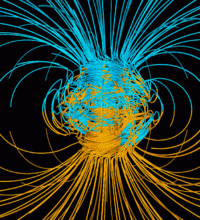
Photo from wikipedia
The paper theoretically studies the process of formation of volume charge in a spacecraft body under action of electron fluxes of Earth’s radiation belts and other cosmic particles, as well… Click to show full abstract
The paper theoretically studies the process of formation of volume charge in a spacecraft body under action of electron fluxes of Earth’s radiation belts and other cosmic particles, as well as the generation of induction currents caused by geomagnetic variations. The BLITS and BLITS-M satellites, which have a spherical configuration manufactured entirely of dielectric materials as well as the metal WESTPAC satellite, are considered. The relative simplicity of the form of a dielectric satellite allows one to obtain an analytical solution to the problem and calculate the distribution of fields and charges inside and on its surface. This solution shows that after the establishment of the stationary mode, charges accumulate mainly in a narrow layer near the satellite surface. According to the obtained estimates for low orbits, the electric field strength in this layer is below the threshold value corresponding to the breakdown of uniform dielectric in laboratory conditions. Nevertheless, one can expect the appearance of local electrical breakdowns and microdestructions in the dielectric during increasing solar activity accompanied by an increase in cosmic-ray fluxes. From this point of view, space experiments, in which dielectric destruction was observed during long-term exposure to radiation, can be interpreted as the result of accumulation of microdestructions similarly to fatigue destruction of materials under long-term load. For passive satellites similar to WESTPAC manufactured of conductive materials, the magnetic moment of induction currents in the spacecraft body is estimated. According to these estimates, the interaction of this moment with the geomagnetic field leading to the precession of the axis of the satellite’s rotation is most significant for Pc5 geomagnetic pulsations.
Journal Title: Cosmic Research
Year Published: 2019
Link to full text (if available)
Share on Social Media: Sign Up to like & get
recommendations!